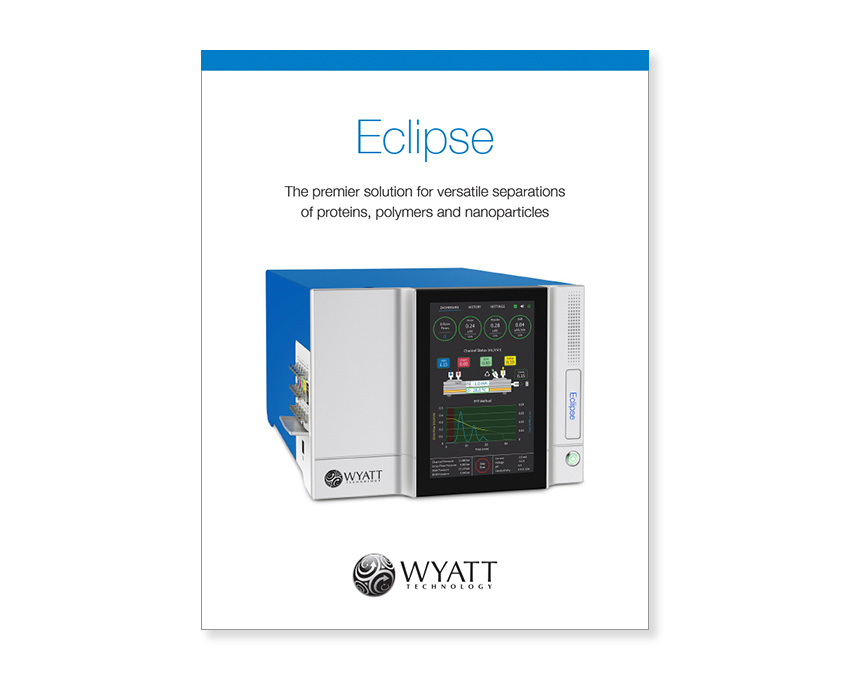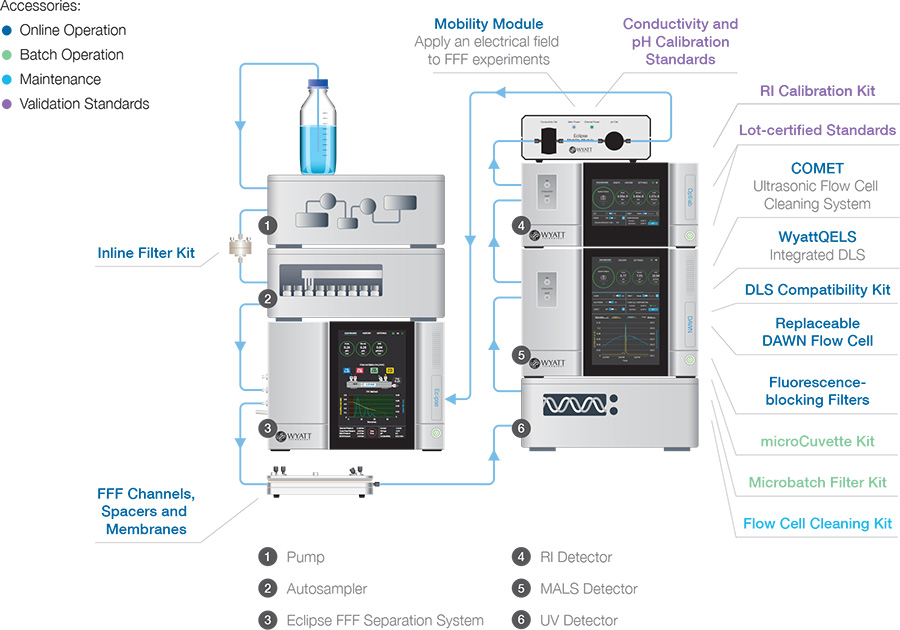Eclipse
Product Overview
Product Description
Brochure
Videos
Options
Mobility EAF4
Channels
Technology
Detectors
Accessories
Specifications
Testimonials
Publications
Request Info

The ultimate separation system for nanoparticles and macromolecules
Uniquely Versatile
Field-flow fractionation is a uniquely versatile means of size-based separations, capable of fractionating viral particles, liposomes and lipid nanoparticles, emulsions, proteins and aggregates, polysaccharides and technical polymers, engineered nanoparticles, colloidal soil suspensions, chemical mechanical polishing slurries, and many more - with no stationary phase and almost no shear. Separation of biotherapeutics can usually be done in full formulation buffer.
The Eclipse™ system is the foundation of FFF-MALS, a powerful technique for separation and comprehensive characterization of macromolecules and nanoparticles from 1 to 1000 nm in size. Eclipse brings FFF to a completely new level, combining exquisite performance and ease of use. Advanced features include the Dilution Control Module™ (DCM) and the ability to switch seamlessly between FFF and size-exclusion chromatography (SEC) separations. The Mobility™ add-on system expands Eclipse’s capabilities to include measurements of charge and zeta potential.
Simplicity and quality, with built-in intelligence
The Eclipse FFF system combines several modules that are integrated seamlessly in VISION software:
- The Eclipse FFF flow instrument
- Agilent 1260 Infinity II pump and autosampler
- Eclipse FFF channel
These modules may be added:
- Agilent 1260 fraction collector
- Mobility EAF4 system
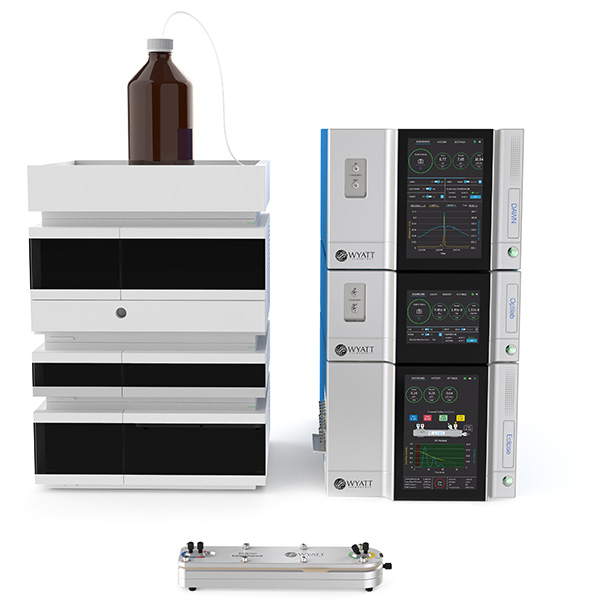
Eclipse instrument
The Eclipse FFF instrument is the heart of the FFF system. It incorporates four highly precise and stable flow controllers that ensure robust and repeatable fractionation runs, without the associated pulsation and inherent complexity and low reliability of the multiple pumps found in other FFF systems.
Eclipse supports both tip injection and focus-zone injection, enabling use of a variety of FFF separation channels and even a size-exclusion chromatography column.
Optional features:
- FFF-SEC switching
- Dilution Control Module (DCM)
(see Options tab for more information)
The user interface is based on a 10” multi-touch display that lets users track progress of the method, know about events or conditions that need attention, and perform any necessary manual operations such as flushing the channel. Built-in intelligence provides health indicators and guided user assistance as well as self-diagnostics procedure.
Front end
The front end for an Eclipse FFF system comprises an Agilent 1260 Infinity II pump and autosampler. These components are recognized by analytical laboratories as state-of-the-art for reliability and performance:
- Low pump ripple and pulsation
- No wasted sample (no need to overfill the autosampler – 100 µL are loaded for a 100 µL injection)
- Used in tens of thousands of laboratories around the world, including in the demanding bio/pharmaceutical industry.

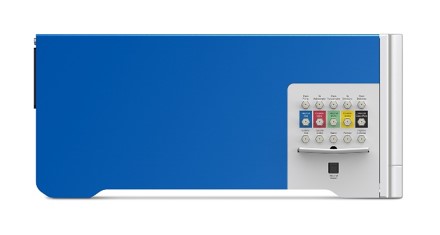
Eclipse FFF channels
Fractionation, which is what it’s all about, takes place in the open FFF channel which incorporates a semi-permeable (ultrafiltration) membrane supported by a frit. Eclipse channels offer several key advantages including extra-rigid construction, built-in temperature regulation and built-in dilution control ports. A variety of FFF channels are available to meet different needs – see the Channels tab to learn more.
VISION™
VISION software is the intelligent human interface to an FFF-MALS system built on Wyatt Technology’s Eclipse™ FFF and DAWN™ MALS instruments. It comprises two primary modules:
- VISION DESIGN™ for in silico method design and optimization
- VISION RUN™ for running FFF methods, with continuous system monitoring and self-diagnostics to ensure no wasted runs, lost sample or empty solvent bottle.
VISION™ interfaces with ASTRA™ software to coordinate synchronization and real-time display of light scattering data within VISION™. Both software packages have been developed under a formal quality system and are available in 21 CFR Part 11 compliant options that fulfill GMP and GLP requirements.
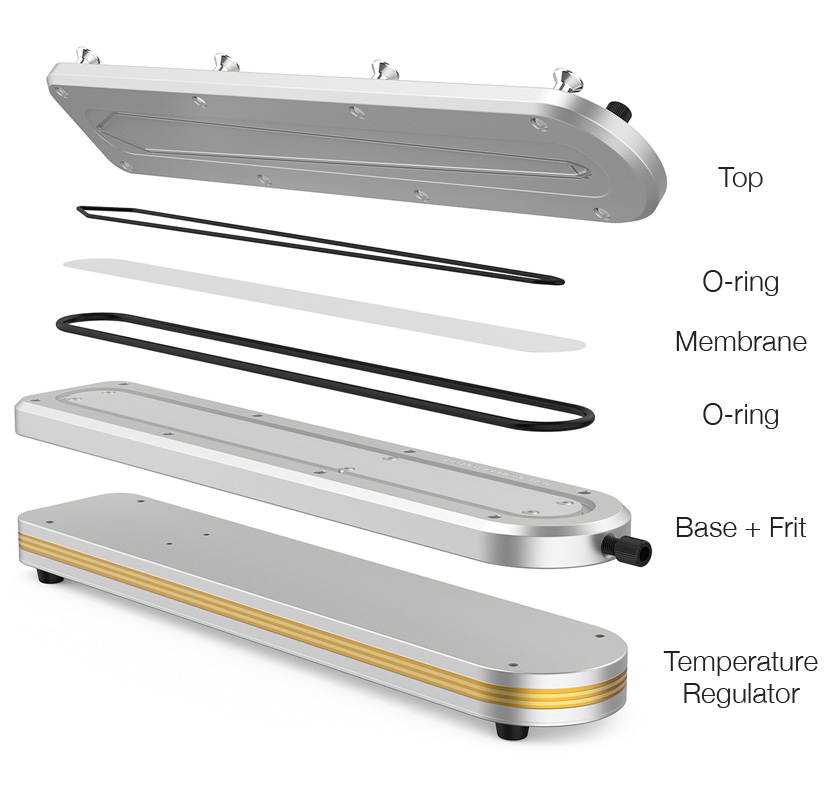
The premier solution for versatile separations of proteins, polymers and nanoparticles
Click here to request a copy of our Eclipse brochure.
View this video to learn more about the technology of field-flow fractionation (FFF) implemented in Wyatt’s Eclipse system. Material covered:
- System modules
- Inside the separation channel
- Solvent and sample flow paths
- How Eclipse separates nanoparticles and macromolecules
Factory-installed options
Dilution Control Module (DCM)
DCM is a major technology advancement in FFF. It increases the detector signal and concentration of collected fractions without loading more sample. This is achieved by splitting away the upper fraction of the channel flow, thereby reducing the dilution of the sample layer at the outlet of the channel. Extensive fluid dynamics simulations and tests were carried out in order to optimize the design for zero sample loss even at high concentration-enhancement ratio.
Eclipse DCM features active control with ultra-high precision and stability of the detector flow, up to 0.1%, providing unmatched reproducibility of retention time and recovery. Variable concentration enhancement up to 10x is possible, and up to 5x without loss of resolution.
Every Eclipse separation channel supports DCM operation, including analytical FFF channels, the semi-prep channel and EAF4 channel.
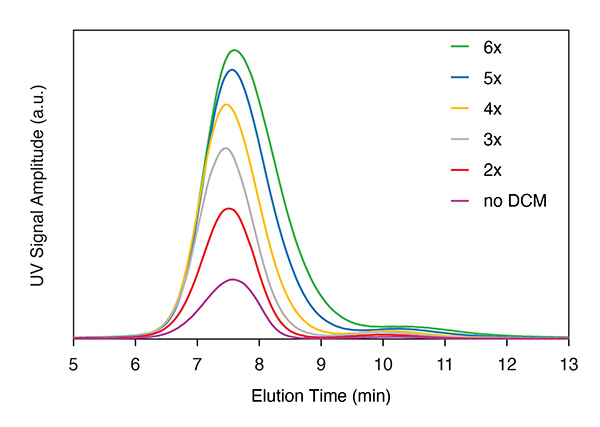
Applying dilution control results in higher sensitivity, increased concentration in collected fractions, lower backpressure and improved dynamic light scattering measurements.
FFF-SEC switching
FFF is very similar to SEC in that both use an HPLC pump, autosampler, a separation module (column in the case of SEC) and downstream detectors. Since Eclipse supports tip injection, where the sample is injected via the main inlet port, it is fully compatible with SEC. The FFF-SEC switching option seamlessly transfers the pump, autosampler and detectors from the FFF channel to an SEC column, so analytical labs involved in macromolecular characterization can make full use of the system in both modes.
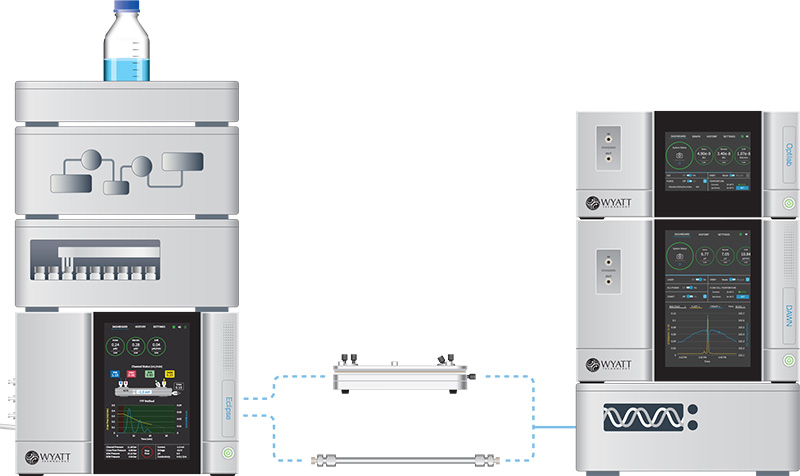
Mobility: measure charge and zeta potential
EAF4
Standard AF4 balances cross flow with diffusion to establish the elution velocity of particles according to size. Electrical/asymmetric-flow field-flow fractionation (EAF4) adds an electric field applied between top and bottom electrodes, and so separates by both size and particle charge (even though the sample never touches an electrode). EAF4 determines zeta potential distributions, even of multimodal and polydisperse populations.

Mobility
The Mobility system, which is an add-on to Eclipse, combines an innovative EAF4 channel design with outstanding software control and analysis. The Mobility module incorporates pH and conductivity sensors which are required to analyze electrophoretic mobility and related properties.
Use Mobility to:
- Understand if all components in the sample have similar surface chemistry
- Evaluate N/P ratio of drug and gene delivery nanoparticles
- Assess biopharmaceuticals for chemical and physical degradation
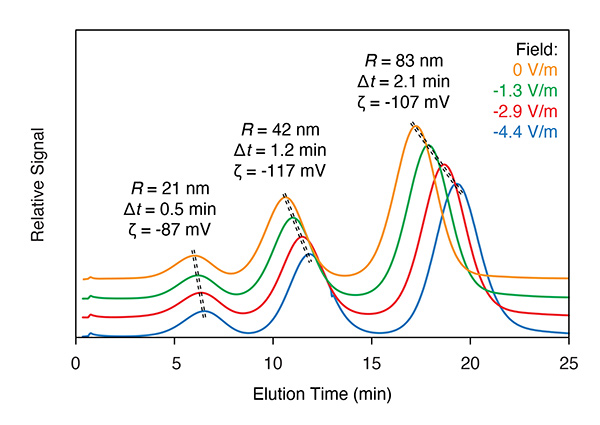
EAF4 analysis of a mixture of polystyrene latex particles. Hydrodynamic radius us determined from retention time at zero applied field, while electrophoretic mobility, charge and zeta potential are determined from the shift in retention time relative the applied field.
FFF channels engineered for top performance and ease of use
Eclipse FFF channels are available in a range of footprints for different sample loads and separation requirements. Except for the Dispersion Inlet Channel, all Eclipse channels implement focus-zone injection to minimize sample loss during focusing.
Short Channel - the workhorse, suitable for most analytical applications.
Long Channel - separation of large particles or polymers can be achieved at low cross flow to minimize membrane interaction.
Dispersion Inlet Channel - eliminates focusing and is the right choice for aggregation-prone samples.
Semi-preparative Channel - separates sample loads up to the milligram range.
Mobility Channel - titanium frame and platinum electrodes for EAF4 separation by size and charge. The channel is guaranteed for a lifetime of 10 years.
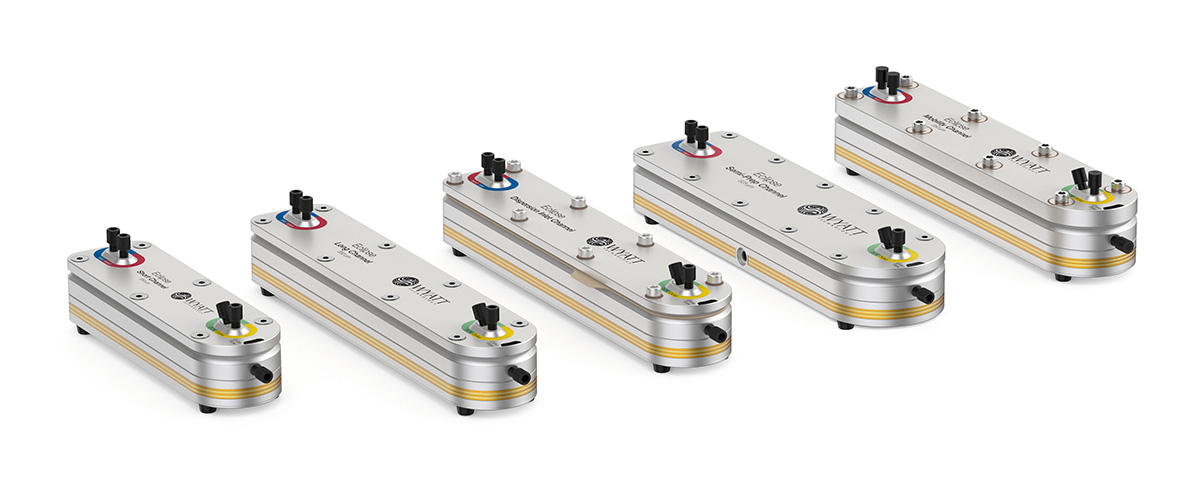
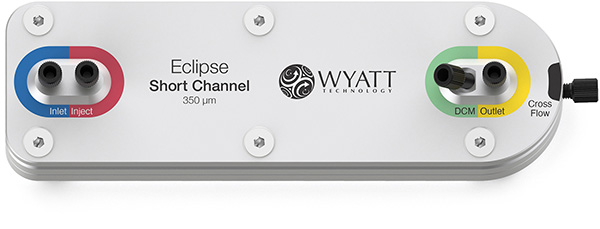
Superior, lasting performance
All stainless-steel construction provides rigidity with no flex or creep, during or between runs. This translates to unprecedented reliability and detector signal quality, while maintaining compatibility with all types of solvents.
Optimized Channel designs serve versatile applications in research and QC operations, with the highest reproducibility and maximum sample recovery.
DCM port is included with all channels, making each one ready for use with the Dilution Control Module to increase sensitivity, fraction concentration, and DLS performance and ensure exquisite repeatability.
Clear labeling and color-coding of connection ports is matched with bulk heads on the instrument side panel. This makes connecting tubing for fluid connections straightforward.
Unmatched reproducibility
In addition to rigidity, stable temperature is critical in ensuring highly reproducible retention times. That’s why all Eclipse channels come with temperature regulation, built right into the channel block, and can regulate the channel from ambient up to 50 ºC. This feature is especially important in long sample sequences carried out overnight or over the weekend, when lab temperatures can fluctuate by several degrees.

A turn-key system incorporating superior technology
An FFF system must be able to precisely control multiple inlet and outlet flows in the separation channel. Reliability and repeatability depend on the number and quality of moving parts, as well as absolute accuracy. That’s why Wyatt’s FFF solution incorporates a single, high-quality pump from the leading provider of HPLC instruments, combined with state-of-the-art flow meters and flow controllers.
An IQ boost
Just measuring and controlling the flows is insufficient for a truly intelligent instrument. The Eclipse incorporates multiple pressure sensors that continuously monitor system health:
- Is the pump OK?
- Has something clogged?
- Is it time to change the membrane?
Eclipse incorporates five sophisticated flow meters and four pressure sensors that stream data continuously. During a run, comprehensive real-time data is displayed on the front panel, plus a strip chart of the method progress, cross-flow program and UV data.
All of that information, plus additional self-diagnostics and preventative maintenance reminders, are automatically verified before and throughout the experiment to ensure maximum productivity and minimum wasted runs.
Problems? No problem.
Key data and system health indicators are displayed on the 10” multi-touch display. If a problem is identified, pop-up screens alert the user and provide actionable recommendations for restoring the system to top performance.
With productivity as the overarching goal of the Eclipse, it was designed for full field serviceability. The Eclipse maintains a log of all operations and alarms. In the unlikely event that any of the internal components fails, a Wyatt service engineer can be onsite, review the diagnostics and log, and restore full operation in a day.
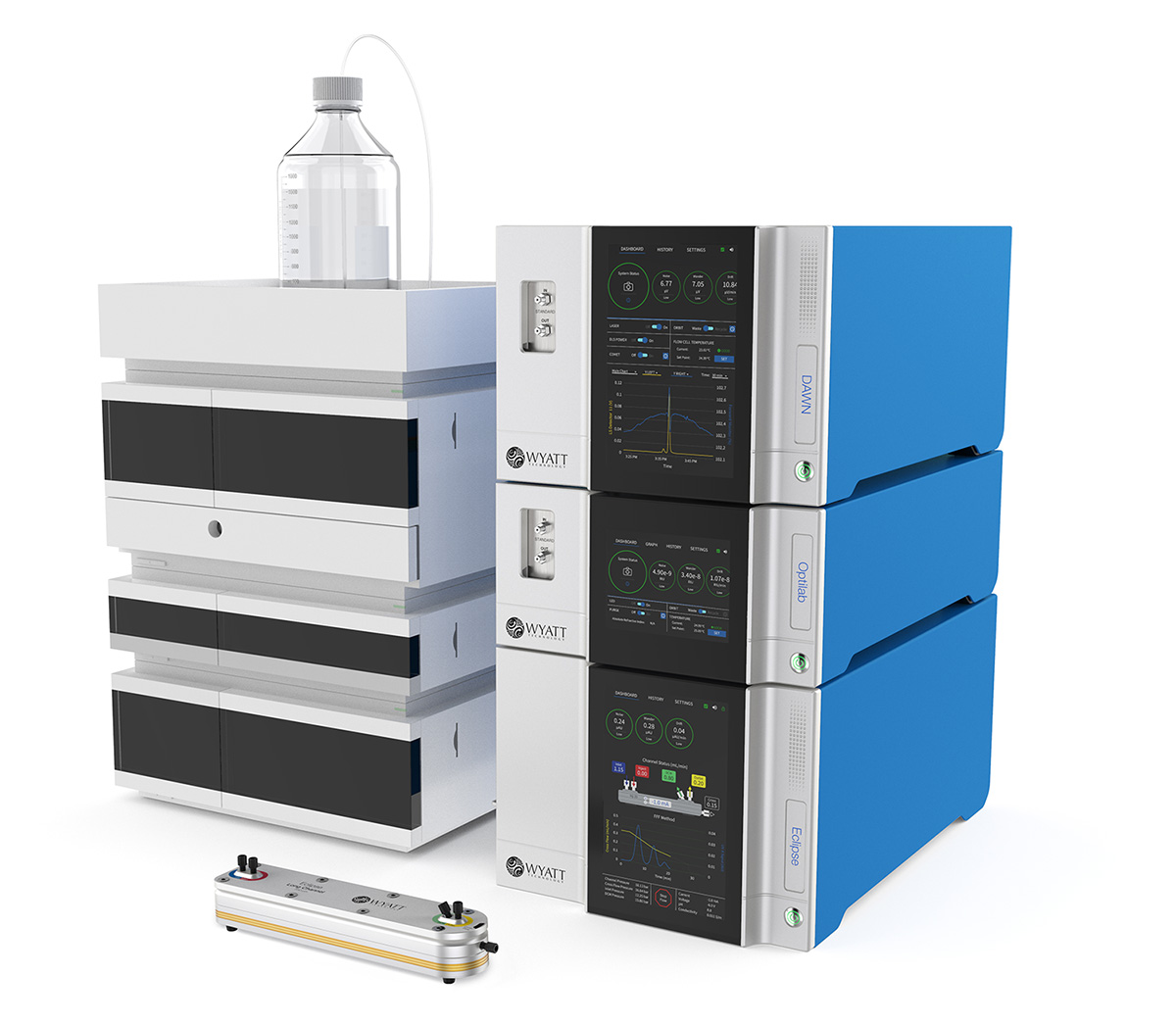
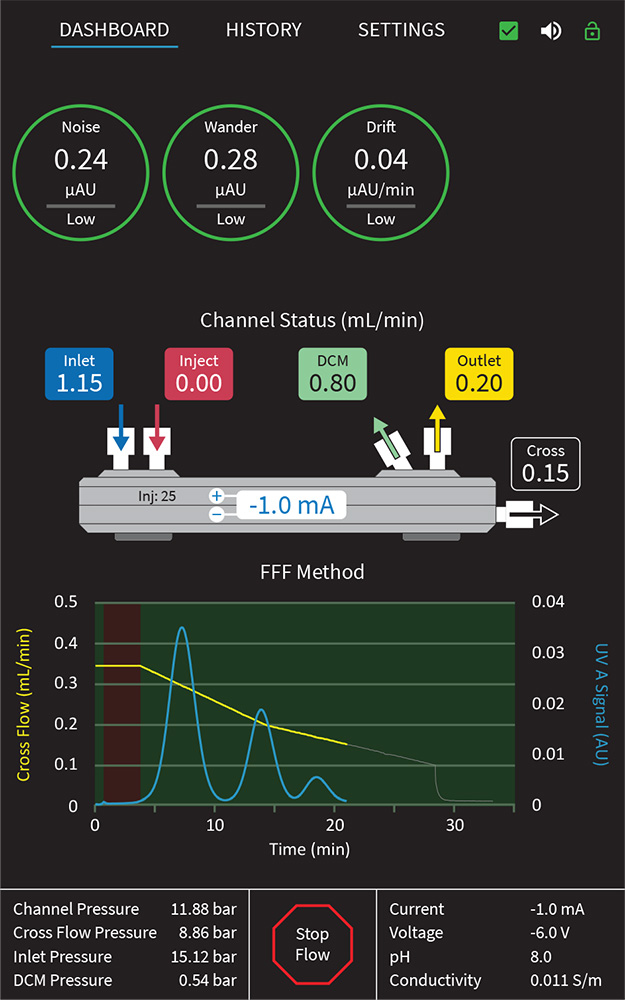
Detectors
MALS detectors
DAWN™ - The most sensitive multi-angle light scattering detector available, anywhere. Incorporates detectors at 18 angles to determine molar masses from 200 Da to 1 GDa and radii from 10 – 500 nm.
- Standard option: ambient temperature
- Heated/cooled option: -15 °C to +150 °C
The DAWN offers special options to handle fluorescent samples: fluorescence-blocking filters and an infrared, 785 nm laser. In addition, the DAWN can be combined with dynamic light scattering for even more comprehensive characterization.
Interested in learning more about DAWN?
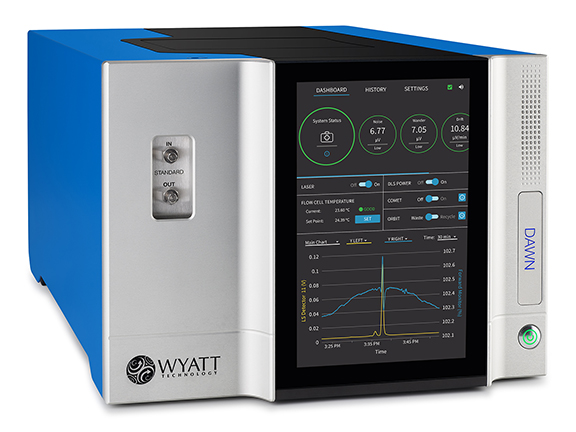
Online DLS
WyattQELS™ - dynamic light scattering module that can be embedded in the DAWN MALS instrument for on-line DLS.
DynaPro™ NanoStar™ - stand-alone dynamic light scattering detector, may be connected via optical fiber to the DAWN flow cell for on-line DLS.
Refractometers
Optilab™ - A unique on-line differential refractometer for measuring concentration of any macromolecule, regardless of chromophores. Temperature controlled from 4 °C to 65 °C. The high-concentration option accommodates protein concentration up to 180 mg/mL.
Interested in learning more about the Optilab?
UV/Vis and fluorescence - The Eclipse system supports industry-standard, online UV/Vis and fluorescence detectors from Agilent, including VWD, MWD, DAD and FLD detectors from the 1260 series.
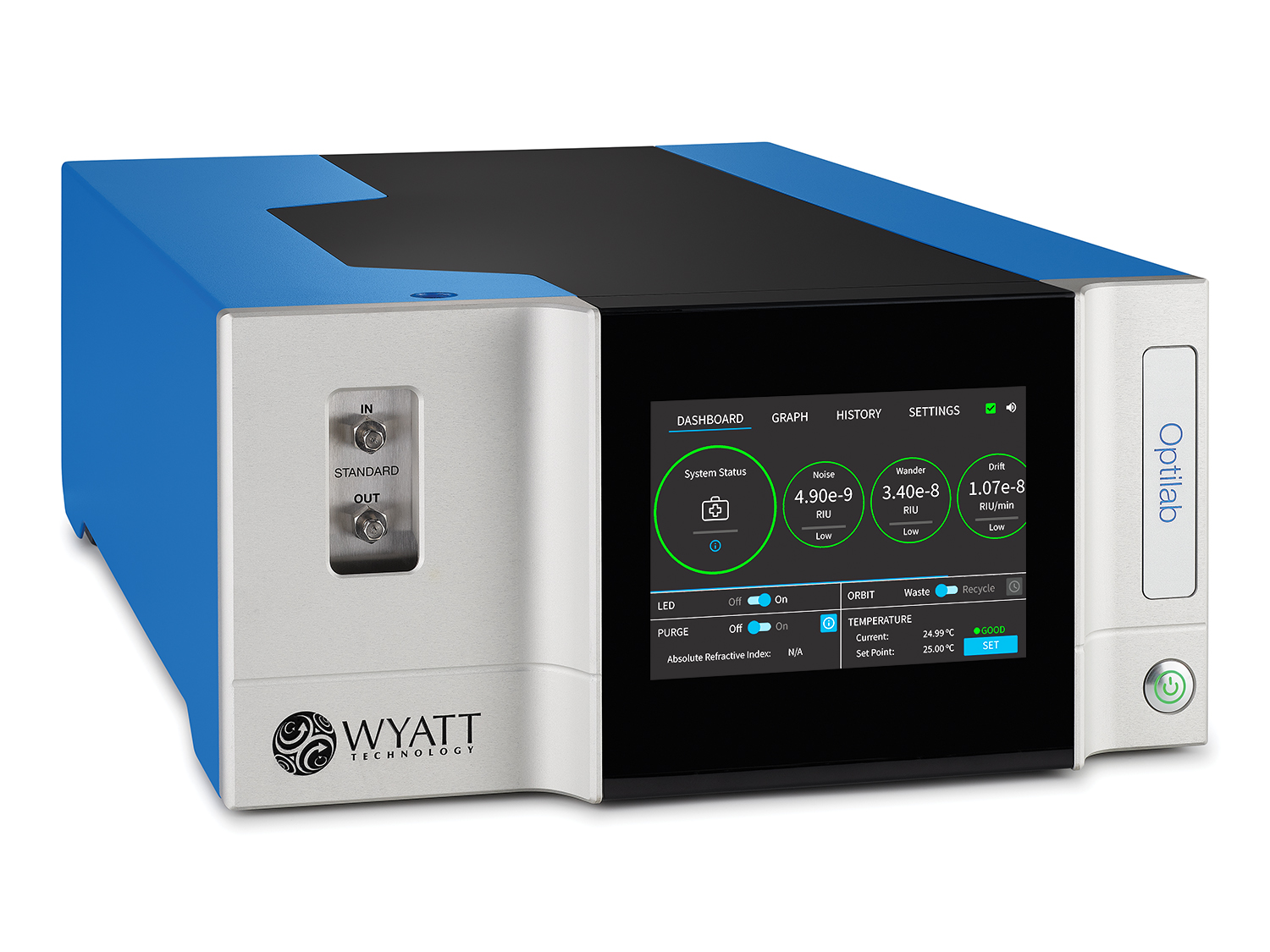
Software
ASTRA™ - Comprehensive software for MALS analysis in chromatography, AF4 or batch mode. ASTRA™ is available in a 21 CFR Part 11 compliant version and offers additional options such as particle analysis. Provides multiple types of conformation analysis including conformation plots, particle concentration and shape factor.
Interested in learning more about ASTRA?
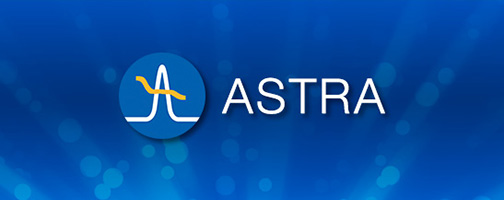
| Eclipse | Compatible with aqueous and organic solvents. Corrosion-resistant from pH 2 to 12. Wetted materials: 316 stainless steel, FFKM perfluoroelastomer, FR3 stainless steel, Vespel. Cross-flow regulation from 6.67 to 0.03 mL/min. Precision of detector flow rate: 0.1% (with DCM). Dedicated fraction collector output port for minimal peak broadening. |
| Communications | Ethernet |
| Inputs/Outputs | Alarm Out, Aux In with 18-bit effective resolution |
| Software | VISION software suite. Comprises VISION DESIGN module for in silico method development and optimization, and VISION RUN for running sequences and coordinating ASTRA data acquisition. |
| FFF-MALS Solution | Basic FFF-MALS system includes Eclipse instrument, one separation channel (matched to customer application), Agilent 1260 Infinity II quaternary pump and autosampler, DAWN MALS instrument, VISION software suite and ASTRA light scattering analysis software. |
| Optional Components | |
| Dilution Control Module | Factory-installed option. Increases sample concentration at the detector by up to a factor of 10 (up to 5 with negligible loss of resolution), controlled by software. |
| SEC Switching Option | Factory-installed option. Allows for automated software-controlled switching between SEC mode and FFF mode. |
| Mobility | Add-on option. Includes Mobility Module with pH sensor and conductivity sensor with software supported calibration, and Mobility channel. Maximum operating voltage ± 30 V, maximum current 30 mA; constant current or constant voltage mode. Wetted materials: platinum, titanium, polyetherimide, alumina ceramic, PTFE, Viton, PEEK, polycarbonate. |
| Agilent 1260 Infinity II | Modules: VWD, MWD, DAD, FLD, fraction collector, etc. |
| DLS | WyattQELS™ embedded dynamic light scattering module |
| Channels | |
| Selection | Short, Long, Dispersion Inlet and Semi-Prep Channels available. Channel types are offered as fixed-height channel (without spacer) and variable-height channel (with spacer) options. All channels are compatible with aqueous and organic solvents and come with DCM port. Maximum pressure 30 bar. |
| Temperature Regulation | Ambient to 50 °C |
| Wetted Materials | 316 stainless steel, fused silica, FFKM perfluoroelastomer, alumina ceramic. Polycarbonate or Mylar according to the selected spacer for variable-height channels. |
| Spacers | Selection ranges from 250 μm to 1000 μm, depending on channel. FFKM perfluoroelastomer-coated polycarbonate for aqueous solvents, Mylar for organic solvents. |
| Membranes | Pre-cut polyethersulfone or regenerated cellulose with molecular-weight cutoff from 2 to 30 kDa. Templates available to cut other materials to size. |
| Dimensions | 58 cm (L) x 36 cm (W) x 26 cm (H) (Eclipse instrument) |
Host PC requirements may be found in Computer Requirements.
Specifications subject to change without notice.

